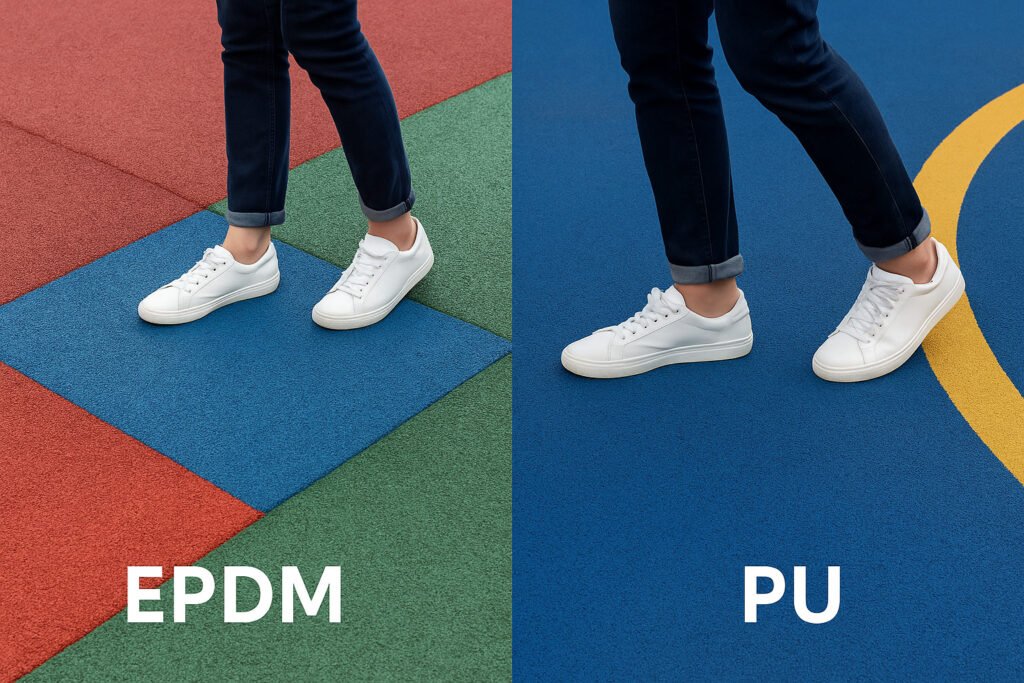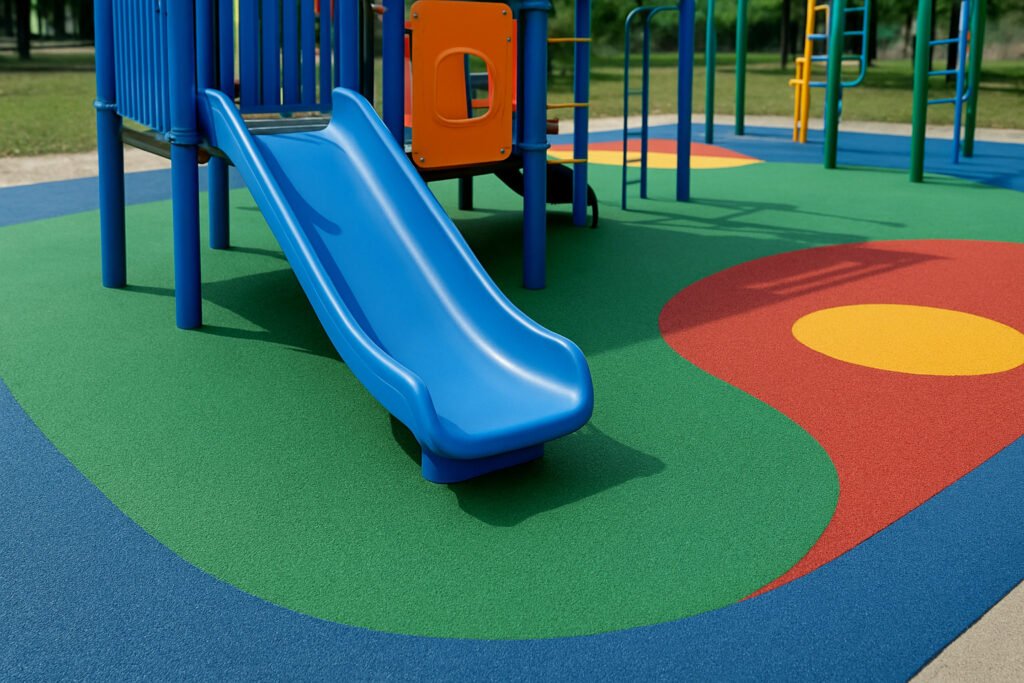EPDM vs. PU for Outdoor Flooring: Which is Better?
Are you struggling to decide between EPDM and PU for your outdoor flooring project?
EPDM rubber flooring is generally more durable, UV-resistant, and cost-effective for outdoor use than PU, especially in public and playground environments.

Choosing between EPDM and PU outdoor flooring? This guide will help you decide which material is safer, longer-lasting, and more suitable for your project. These are the facts your rubber flooring supplier won’t always tell you.
What is EPDM and Why Is It Ideal for Outdoor Use?
EPDM granule flooring provides superior resistance to UV, weather, and impact — ideal for kindergartens, parks, and playgrounds.

EPDM Strengths Overview
| Feature | EPDM Granules (Lanhefloor) |
|---|---|
| UV Resistance | Excellent – no fading under sunlight |
| Shock Absorption | High – 10–15mm thickness recommended |
| Color Variety | Custom – red, green, blue, yellow, and more |
| Certification | EN1177 & CE certified |
| Maintenance | Easy – long-lasting and low effort |
| Installation | Poured-in-place over cushion layer (PU binder 22%) |
At Lanhefloor, our EPDM surfaces are widely used for outdoor sports flooring. They’re seamless, safe, and available in custom patterns and graphics.
What is PU Flooring and How Does It Compare?
PU (Polyurethane) is popular for indoor sports flooring. Outdoors? Not so much. UV and weather exposure reduce its lifespan quickly.
PU vs EPDM: Outdoor Performance
| Feature | PU Flooring | EPDM Flooring |
|---|---|---|
| UV Resistance | Moderate – prone to fading | Excellent |
| Weatherproofing | Can crack under hot/cold cycles | Flexible and stable |
| Shock Absorption | Medium | High |
| Maintenance | Recoating every 2–3 years | Minimal upkeep |
| Installation | Spray or roller | Poured-in-place granules |
| Color Stability | Fades over time | Bright, long-lasting |
Which Is Safer for Playgrounds and Public Areas?
EPDM surfaces are fully certified under EN1177, while PU often lacks compliant cushioning layers for outdoor falls.
Child Safety Comparison
| Safety Factor | PU Floor | EPDM Granules |
|---|---|---|
| Playground Certified | No (requires extra layers) | Yes – EN1177 certified |
| Slip Resistance | Good when dry | Excellent, even when wet |
| Impact Resistance | Medium | High (with cushion base) |
| Custom Graphics | Limited | Custom patterns/logos supported |
Schools and municipalities often choose EPDM for safety, durability, and better parent feedback.
Which Option Saves More in the Long Run?
EPDM may cost slightly more upfront, but it outlasts PU and reduces maintenance costs significantly.
Cost and Lifespan Comparison
| Metric | PU Flooring | EPDM Granule Flooring |
|---|---|---|
| Initial Cost | Lower | Slightly Higher |
| Lifespan | 3–5 years | 8–10+ years |
| Recoating Needed | Yes | No |
| Maintenance Frequency | High | Low |
| Total Cost (10 years) | Higher | Lower |
Conclusion: EPDM Wins for Outdoor Use
If you’re building a long-term outdoor surface — go with EPDM outdoor rubber flooring. It’s safer, lasts longer, and saves more money over time.
Related Resources
- EPDM Granules for Playgrounds
- Is Rubber Flooring Safe for Outdoor Playgrounds?
- EPDM vs. SBR Rubber Comparison
- ASTM F1292 Standard
- Get Factory Pricing for EPDM
FAQs About EPDM and PU Outdoor Flooring
Is EPDM better than PU for playgrounds?
Yes, EPDM is certified for playground safety, resists UV rays, and has better shock absorption than PU.
How long does EPDM outdoor flooring last?
With proper installation, EPDM lasts 8–10+ years, even in extreme outdoor conditions.
Does PU flooring crack outdoors?
Yes, PU surfaces tend to degrade and crack due to UV and thermal cycling.
Can I customize EPDM flooring?
Absolutely! EPDM can be installed in custom patterns, logos, and vibrant color mixes.
Where can I use EPDM flooring?
Perfect for kindergartens, sports tracks, fitness parks, schools, and public safety zones.
Need a quote or technical consultation? Contact Lanhefloor now.
